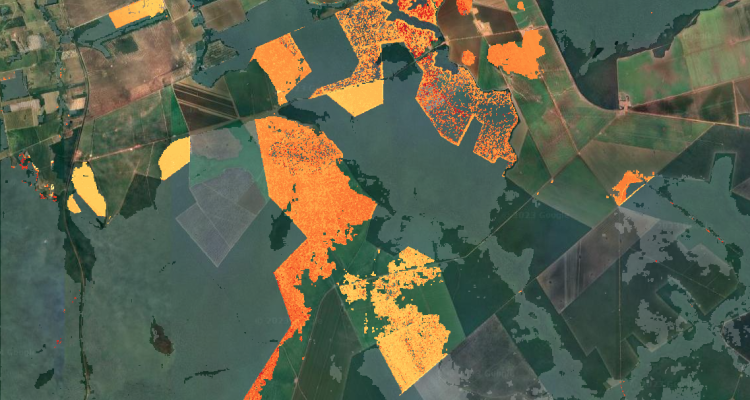
News
How textural features can improve SAR-based tropical forest disturbance mapping
An article of Johannes Balling, Martin Herold and Johannes Reiche: How textural features can improve SAR-based tropical forest disturbance mapping, has been published in the International Journal of Applied Earth Observation and Geoinformation, Volume 124, November 2023, 103492.
Abstract
Spatially and timely accurate information about tropical forest disturbances is crucial for tracking critical forest changes, supporting forest management, and enabling law enforcement activities. In recent years, forest disturbance monitoring and alerting using cloud-penetrating Synthetic Aperture Radar (SAR) imagery has proven effective at national and pan-tropical scales. Related detection approaches mostly rely on detecting post-disturbance altered backscatter values in C or L-band SAR backscatter time series. Some disturbances are characterized by post-disturbance tree remnants or debris. For the time periods where these kinds of remnants remain present at the surface, the SAR backscatter values can be similar to those of stable forest. This can cause omission errors and delayed detection and it is considered a key shortcoming of current backscatter-based approaches. We hypothesized that despite fairly stable backscatter values, different orientation and arrangement of tree remnants leads to an altered heterogeneity of neighboring pixel values and that this can be quantified by textural features. We assessed six uncorrelated Gray-Level Co-Occurrence Matrix (GLCM) textural features using dense Sentinel-1C-band SAR time series. Forest disturbances, based on each GLCM feature using a pixel-based probabilistic change detection algorithm, were compared against results from forest disturbances mapped based only on backscatter data. We studied the impact of speckle-filtering on GLCM features and GLCM kernel sizes. We developed a method to combine backscatter and GLCM features, and we evaluated its robustness for a variety of natural and human-induced forest disturbance types across the Amazon Biome. Out of the six tested GLCM features GLCM Sum Average (SAVG) performed best. GLCM features derived from non-speckle filtered and speckle-filtered backscatter data did not show a noticeable impact on accuracy. A combination of backscatter and GLCM SAVG resulted in a reduced omission error of up to 36% and an improved timeliness of detections by average of to 30 days, with individual detection showing even higher improvements on a pixel level. The method was found to be robust across a variety of forest disturbance types. The largest reduction of omission errors and greatest improvement of timeliness was evident for sites with large unfragmented disturbance patches (e.g., large-scale clearings, fires and mining). For increasing GLCM kernel sizes, we observed a trade-off between reduced omission errors combined with improved timeliness and increasing commission errors. A kernel size of 5 was found to provide the best trade-off for reducing omission errors and improving timeliness while not introducing commission errors. The results emphasize that combining SAR-based textural features and backscatter can overcome omission errors caused by post-disturbance tree remnants or debris. This can help to improve the consistency and timelines of short (C-band) and long wavelength (L-band) based operational SAR disturbance monitoring and alerting.
Spatially and timely accurate information about tropical forest disturbances is crucial for tracking critical forest changes, supporting forest management, and enabling law enforcement activities. In recent years, forest disturbance monitoring and alerting using cloud-penetrating Synthetic Aperture Radar (SAR) imagery has proven effective at national and pan-tropical scales. Related detection approaches mostly rely on detecting post-disturbance altered backscatter values in C or L-band SAR backscatter time series. Some disturbances are characterized by post-disturbance tree remnants or debris. For the time periods where these kinds of remnants remain present at the surface, the SAR backscatter values can be similar to those of stable forest. This can cause omission errors and delayed detection and it is considered a key shortcoming of current backscatter-based approaches. We hypothesized that despite fairly stable backscatter values, different orientation and arrangement of tree remnants leads to an altered heterogeneity of neighboring pixel values and that this can be quantified by textural features. We assessed six uncorrelated Gray-Level Co-Occurrence Matrix (GLCM) textural features using dense Sentinel-1C-band SAR time series. Forest disturbances, based on each GLCM feature using a pixel-based probabilistic change detection algorithm, were compared against results from forest disturbances mapped based only on backscatter data. We studied the impact of speckle-filtering on GLCM features and GLCM kernel sizes. We developed a method to combine backscatter and GLCM features, and we evaluated its robustness for a variety of natural and human-induced forest disturbance types across the Amazon Biome. Out of the six tested GLCM features GLCM Sum Average (SAVG) performed best. GLCM features derived from non-speckle filtered and speckle-filtered backscatter data did not show a noticeable impact on accuracy. A combination of backscatter and GLCM SAVG resulted in a reduced omission error of up to 36% and an improved timeliness of detections by average of to 30 days, with individual detection showing even higher improvements on a pixel level. The method was found to be robust across a variety of forest disturbance types. The largest reduction of omission errors and greatest improvement of timeliness was evident for sites with large unfragmented disturbance patches (e.g., large-scale clearings, fires and mining). For increasing GLCM kernel sizes, we observed a trade-off between reduced omission errors combined with improved timeliness and increasing commission errors. A kernel size of 5 was found to provide the best trade-off for reducing omission errors and improving timeliness while not introducing commission errors. The results emphasize that combining SAR-based textural features and backscatter can overcome omission errors caused by post-disturbance tree remnants or debris. This can help to improve the consistency and timelines of short (C-band) and long wavelength (L-band) based operational SAR disturbance monitoring and alerting.